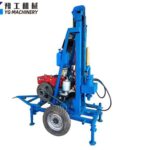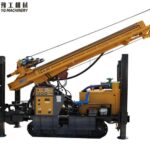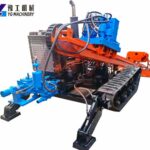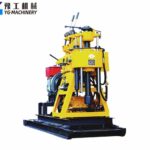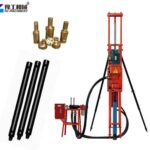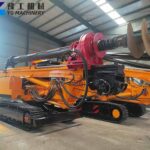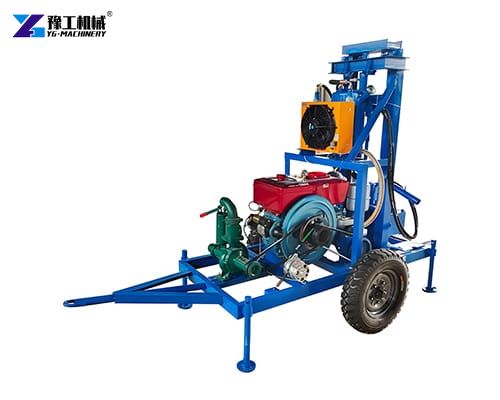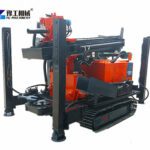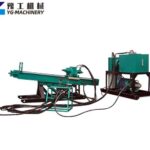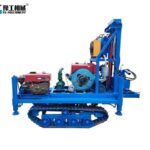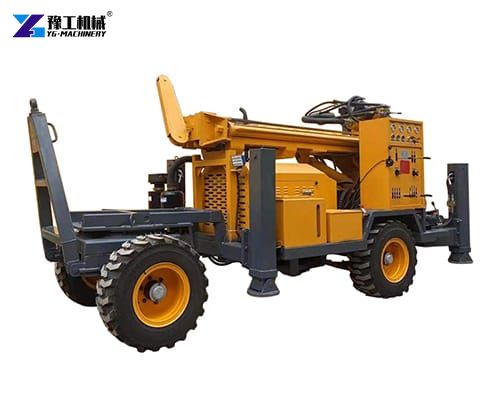DTH drilling rig is characterized by its unique ability to deliver impact energy directly to the drill bit through a down-the-hole hammer. This design minimizes energy loss and enhances drilling efficiency, making them ideal for a wide range of applications including mining, construction, and water well drilling. The core components of a DTH drilling rig include the drill string, down-the-hole hammer, compressor, and drilling controls.
Structural Components of DTH Drilling Machine
- Drill String: The drill string consists of interconnected drill rods that transmit torque and axial force from the surface to the drill bit. It serves as the backbone of the drilling system, ensuring stability and precision during drilling operations.
- Down-the-Hole Hammer: This is the heart of the DTH drilling rig. Mounted at the end of the drill string, the hammer uses compressed air to propel a piston that strikes the anvil, transmitting impact energy to the drill bit.
- Compressor: The compressor supplies compressed air to the down-the-hole hammer, ensuring continuous and reliable operation. It is crucial for maintaining the high impact frequency and force required for efficient drilling.
- Drilling Controls: These include various mechanisms for adjusting drilling parameters such as feed force, rotation speed, and impact frequency. Proper control of these parameters is essential for optimizing drilling performance and extending equipment life.
Working Principles of DTH Drilling Rig
The working principle of a DTH drilling machine is based on the combination of impact and rotary drilling methods. Here’s a step-by-step breakdown:
- Initiation of Drilling: The drill string, equipped with the down-the-hole hammer and drill bit, is lowered into the hole. Compressed air is supplied to the hammer through the drill string.
- Impact Action: As the compressed air acts on the piston within the hammer, it reciprocates rapidly, striking the anvil and transmitting impact energy to the drill bit. This high-frequency impact crushes and fractures the rock.
- Rotary Action: Simultaneously, the drill string rotates, causing the drill bit to scrape and cut the rock surface. The combined action of impact and rotation enhances drilling efficiency and reduces energy consumption.
- Rock Removal: Compressed air is also used to flush the hole, removing cuttings and debris generated during drilling. This ensures that the drill bit remains in contact with the rock surface, maintaining drilling efficiency.
Types and Classifications
DTH drilling rigs come in various types and sizes, catering to different drilling requirements. They can be classified based on factors such as drilling depth, hole diameter, and power source.
- By Drilling Depth: Shallow-hole, medium-hole, and deep-hole drilling rigs are available. Shallow-hole rigs are typically used for water well drilling and small-scale construction projects, while medium- and deep-hole rigs are more suited for mining and large-scale infrastructure projects.
- By Hole Diameter: Rigs designed for drilling holes ranging from small diameters to large diameters are available. The choice of hole diameter depends on the specific application and rock conditions.
- By Power Source: Hydraulic and pneumatic DTH drilling machines are the two main types. Hydraulic rigs use hydraulic fluid to power the drilling mechanism, while pneumatic rigs rely on compressed air. Hydraulic rigs are often more powerful and versatile, suitable for a wider range of applications.
Down the Hole Drilling Equipment Application
Down the hole drilling rig find applications across multiple industries, showcasing their versatility and efficiency.
- Mining: In the mining industry, DTH drilling rig is used for blast hole drilling, exploration drilling, and production drilling. They are essential for extracting minerals such as coal, metal ores, and gemstones.
- Construction: In the construction sector, these rigs are used for pile driving, foundation drilling, and anchoring. They play a critical role in building infrastructure such as bridges, highways, and buildings.
- Water Well Drilling: For water well drilling, DTH rigs are used to create boreholes for extracting groundwater. They are particularly effective in hard rock formations where traditional drilling methods may struggle.
- Geothermal Energy: In geothermal energy projects, DTH rigs are used to drill wells for extracting geothermal fluid. This fluid is then used to generate electricity or for direct heating and cooling applications.
- Environmental Drilling: These rigs are also used for environmental drilling, including soil sampling and groundwater monitoring. They help assess contamination levels and guide remediation efforts.

